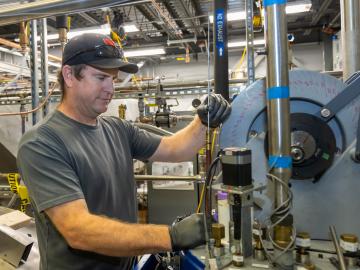Filter News
Area of Research
- Biology and Environment (14)
- Clean Energy (60)
- Computational Engineering (2)
- Computer Science (6)
- Electricity and Smart Grid (1)
- Fusion and Fission (3)
- Isotopes (10)
- Materials (18)
- Materials for Computing (2)
- Mathematics (1)
- National Security (15)
- Neutron Science (4)
- Nuclear Science and Technology (5)
- Quantum information Science (3)
- Sensors and Controls (1)
- Supercomputing (5)
- Transportation Systems (2)
News Type
News Topics
- (-) Clean Water (19)
- (-) Grid (27)
- (-) Isotopes (13)
- (-) Machine Learning (14)
- (-) Mercury (7)
- (-) Molten Salt (5)
- (-) National Security (18)
- (-) Physics (21)
- (-) Quantum Science (12)
- (-) Transportation (47)
- 3-D Printing/Advanced Manufacturing (42)
- Advanced Reactors (15)
- Artificial Intelligence (16)
- Big Data (20)
- Bioenergy (31)
- Biology (37)
- Biomedical (19)
- Biotechnology (6)
- Buildings (27)
- Chemical Sciences (15)
- Climate Change (35)
- Composites (11)
- Computer Science (51)
- Coronavirus (17)
- Critical Materials (13)
- Cybersecurity (9)
- Decarbonization (22)
- Energy Storage (45)
- Environment (79)
- Exascale Computing (3)
- Frontier (3)
- Fusion (16)
- High-Performance Computing (19)
- Hydropower (8)
- Irradiation (2)
- ITER (4)
- Materials (42)
- Materials Science (45)
- Mathematics (4)
- Microscopy (20)
- Nanotechnology (18)
- Net Zero (3)
- Neutron Science (35)
- Nuclear Energy (32)
- Partnerships (1)
- Polymers (13)
- Quantum Computing (5)
- Security (7)
- Simulation (10)
- Space Exploration (10)
- Statistics (1)
- Summit (8)
- Sustainable Energy (57)
Media Contacts

Associate Technician Sean Hollander is the keeper of the Fundamental Neutron Physics Beamline, which is operated by the Physics Division at the Spallation Neutron Source at ORNL, where scientists use neutrons to study all manner of matter.

Mohamad Zineddin hopes to establish an interdisciplinary center of excellence for nuclear security at ORNL, combining critical infrastructure assessment and protection, risk mitigation, leadership in nuclear security, education and training, nuclear security culture and resilience strategies and techniques.

Groundwater withdrawals are expected to peak in about one-third of the world’s basins by 2050, potentially triggering significant trade and agriculture shifts, a new analysis finds.

ORNL’s Assaf Anyamba has spent his career using satellite images to determine where extreme weather may lead to vector-borne disease outbreaks. His work has helped the U.S. government better prepare for outbreaks that happen during periods of extended weather events such as El Niño and La Niña, climate patterns in the Pacific Ocean that can affect weather worldwide.

A team of researchers at ORNL demonstrated that a light-duty passenger electric vehicle can be wirelessly charged at 100-kW with 96% efficiency using polyphase electromagnetic coupling coils with rotating magnetic fields.

To capitalize on AI and researcher strengths, scientists developed a human-AI collaboration recommender system for improved experimentation performance.

ORNL climate modeling expertise contributed to a project that assessed global emissions of ammonia from croplands now and in a warmer future, while also identifying solutions tuned to local growing conditions.

Louise Stevenson uses her expertise as an environmental toxicologist to evaluate the effects of stressors such as chemicals and other contaminants on aquatic systems.

Electric vehicles can drive longer distances if their lithium-ion batteries deliver more energy in a lighter package. A prime weight-loss candidate is the current collector, a component that often adds 10% to the weight of a battery cell without contributing energy.

Oak Ridge National Laboratory researchers have identified the most energy-efficient 2024 model year vehicles available in the United States, including electric and hybrids, in the latest edition of the Department of Energy’s Fuel Economy Guide.




